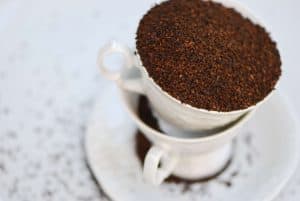Chicory root is a common additive to food. It is also known as inulin. You can read more to find out specifics and the pros and cons of Inulin.
Chicory, or Cichorium intybus, grows in the United States and is cultivated in Mediterranean areas in Europe. Chicory is a woody, perennial herbaceous plant of the dandelion family, usually with bright blue flowers, but they can also be white or pink. It is a common weed that has been naturalized in various world areas. Chicory root is roasted, ground, and used as a coffee substitute, especially in New Orleans, in particular, because it has a similar taste. Chicory is caffeine free and is cheaper than coffee. During World War II and the Great Depression, when shipping from coffee-producing countries was disrupted, and coffee became too much of a luxury due to cost, chicory was used in the United States to produce “coffee.” Chicory also has been added to certain European beers and ales.
What else is Chicory used for?
- Leaves: Leaf chicory is radicchio. It usually has variegated red or red and green leaves. Some only refer to the white-veined red-leaved type as radicchio, also known as red endive and red chicory. It has a bitter and spicy taste, which mellows when it is grilled or roasted. It can also be used to add color and zest to salads. It is largely used in Italy and Greece.
- Root Extract:
- It contains inulin and is used as a sweetener. One-tenth as sweet as sucrose
- Fiber replacement and additive
- Fat replacement due to its creamy texture
Are there any medicinal uses?
The big answer is maybe. I recommend discussing these with your medical provider before you start adding chicory root to your diet. The claimed medicinal benefits:
- Intestinal Parasites: Chicory root contains tansy, which is toxic to intestinal worms. There is some research to back this up, but pills are cheap. See a medical provider.
- Reduces stress: Doubtful. The only way this product reduces stress is by replacing your coffee with chicory root to reduce caffeine consumption. That being said, reducing caffeine will lower cortisol and the stress hormone epinephrine. Caffeine has also been shown to be good in dieting and exercise, so I would not drop it just yet.
- Bone Density: Most studies are in rats, but chicory root might increase calcium absorption and thus affect bone mass. More research is needed.
- Anti-diabetic Effect: Some research shows that chicory root may lower or slow the onset of diabetes type 2 in those at risk of developing it. This makes sense fiber does slow the absorption of sugars and carbohydrates. Research is sketchy, but it is unlikely to do any harm. I will not take it with your diabetes oral medication if you are already diabetic.
- Anti-inflammatory Effect: The root contains plant polyphenols postulated to reduce inflation.
- Liver Cleanse: It is believed to increase gall bladder emptying. For this reason, it has been postulated to help detoxify the liver. It may help empty the gallbladder, but that could be a problem if you have stones or sludge in the gallbladder.
- Reduce Constipation: This one is real. It is fiber. The only downside is it may not protect against colon cancer. There is no research to prove it has the same effect as other bulking agents.
- Reduce Cholesterol: It makes sense if it reduces or slows fat absorption.
What are the risks?
It might trigger reactions in people who are allergic to ragweed pollen and are sensitive to related plants, including chrysanthemums, marigolds, daisies, and other members of the Asteraceae/Compositae plant family. Because chicory can stimulate the production of bile and contraction of the gall bladder, consuming it can cause gall bladder symptoms in those with gall bladder disease or stones. I personally have never seen this in a patient, but it is possible.
Why is it added to foods?
Chicory, when eaten, doesn’t produce a rise in blood sugar. Chicory root contains inulin which is a carbohydrate fiber that is less absorbable. Sometimes called “chicory root fiber,” inulin is also found in bananas, wheat, onions, and garlic, but chicory root has very high concentrations. Food manufacturers now extract inulin from chicory root and add it to edible products such as yogurt, ice cream, chocolate bars, breakfast bars, salad dressings, and margarine. Because it has a smooth and creamy texture, it has been called the “stealth fiber,” It also works well as a replacement for fat. Like other high-fiber foods, inulin prevents constipation, helps maintain a healthy balance of “good” bacteria in the colon, and helps lower cholesterol levels. It can also be used as a sweetener in processed foods, but its sweetening power is one-tenth that of sucrose, so it takes more to create the same level of sweetness.
Why does Chicory Root make me gassy?
Chicory root makes you toot. The only problem with inulin may be that it doesn’t have the texture or taste of fiber. It is often added to cookies and bars to add fiber and sweetness without calories. The texture hides the fact that it is high in fiber. This makes it easy to consume too much and brings on the same kind of digestive problems caused by an excess of any fiber, such as gas/bloating, nausea, flatulence, stomach cramping, diarrhea, constipation, and digestive “rumbling.” Ten grams of native inulin and five grams of “sweet” inulin are probably safe. Flatulence was the most common symptom; hence it earned the toot nickname. I can’t help remembering a flight from the Middle East where a traveler ate a whole box of chicory root-containing cereal bars by herself and asked me why she had such discomfort. Stick to one bar a day, and you will avoid her discomfort followed by embarrassment as the noxious odor fills the aircraft’s cabin. Because of the gas and bloating, I recommend watching how much you eat. Do it for those around you, or you may be standing alone.
The bottom line: Inulin or chicory root is a decent source of fiber and can be one method to supplement. Just be cognizant that it might make those around you miserable.











Be the first to comment on "Nutrition: What is Chicory Root or Inulin?"